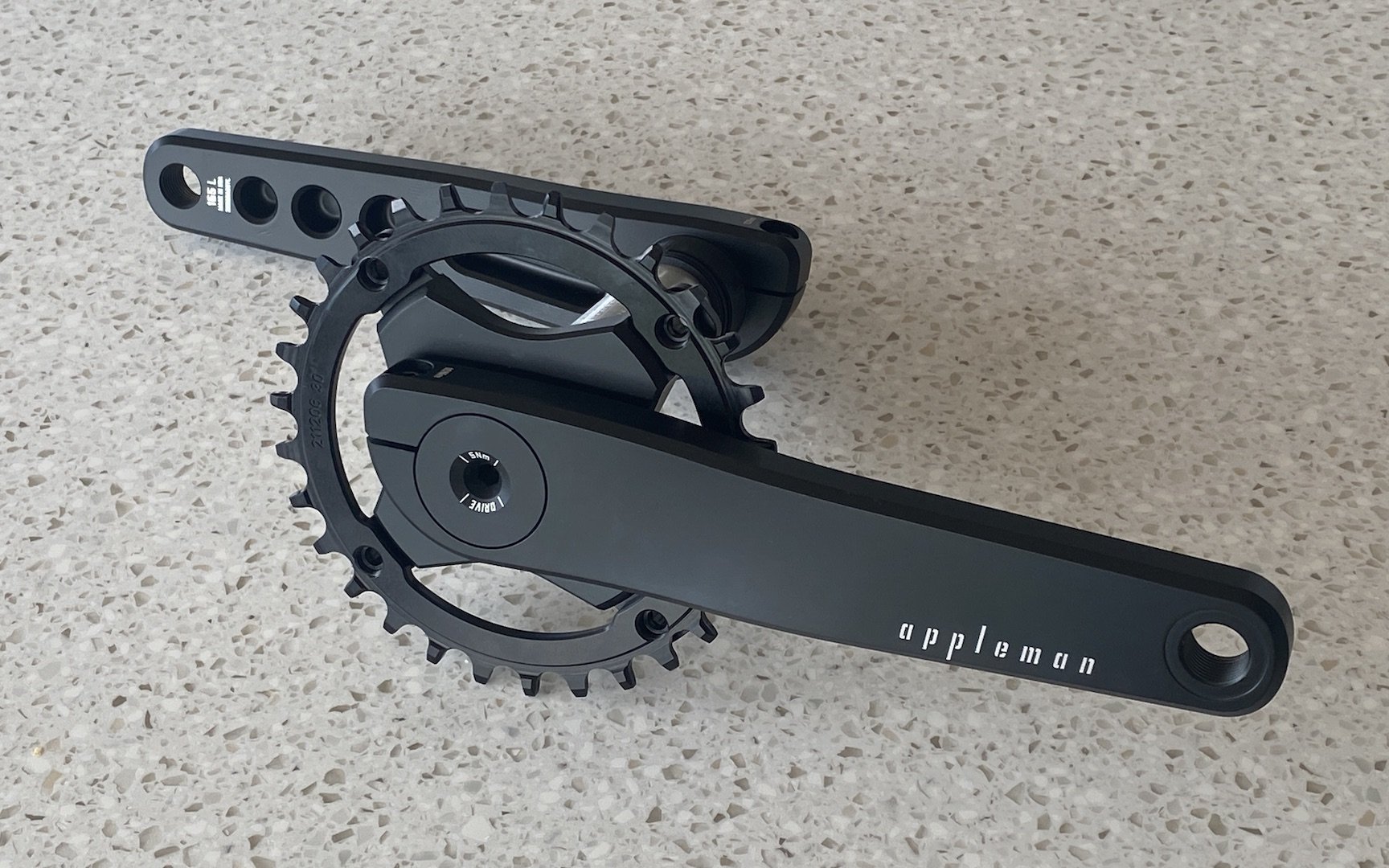
Review
Appleman 2XR Cranks - Made in Minneapolis
Who made your cranks? Do you know their name? Can you picture a face? Or maybe multiple faces? I've met the person who designed my cranks, finished them, painted them, and added the laser etching. And he's met the machinists who programmed the CNC machines that carved them into the shapes you see above. All of this happened in Minneapolis, Minnesota. Does this providence make them any better than other cranks I've used? Probably not, but the cookies grandma made always tasted better than any from a bakery. There is something satisfyingly wholesome about knowing about the people who created the parts of your bicycle. I have nothing against the people who make cranks in Taiwan or Portugal or Japan or China or anywhere else, but I don't know them, and they may not have any emotional attachment to the process, the design, or the finished product, unlike Matt Appleman. And, also unlike Matt Appleman, they probably aren't trying to teach us something new.

Matt Appleman from his shop in Minneapolis. The guy responsible for these cranks (along with a couple of Minnesota machinists)
There are many criteria behind the choice of a test product. I might choose something because I know it's of interest to our audience, or because it looks cool, or is excellent value, or breaks new ground in terms of performance, but more than anything else, I'm drawn to story. Appleman cranks have a good story, and I got a chance to hear it from Matt Appleman himself, all the way from Minneapolis.
Matt seems like a pure soul, the sort who could never utter a falsehood or speak ill of anyone, dead or otherwise. He has the sort of genuine character that is becoming rare outside the American midwest. The sort of guy you would trust with your life, and he'd give you a warm smile after saving your bacon.

This is what comes in the box when you order Appleman 2XR cranks (minus the chainring). I love the look of these cranks. They are some of the prettiest out there IMHO. Photo - Cam McRae
First, Carbon Frames...
Mr. Appleman didn't start out making cranks at all. His core business is building custom carbon frames. Matt studied composite engineering at University but with an ulterior motive; he wanted to build a frame that would fit him. Thankfully Matt didn't have a roommate because this started in his dorm long before graduation. Today it's Matt's main business and it's a long process. Matt only builds 10 to 12 frames a year.
Matt wasn't motivated by the desire to be his own crank supplier; he was moved by pain. Years ago Matt, who has raced track, road, and cyclocross, got to the point where he couldn't ride without significant discomfort:
"So I built a custom frame for myself, got into a much better position that was easier on my knees. I was still riding 172.5s as I always had. And that was okay, I could pedal but any sort of any ride over 20, 30 miles or if I went too hard, I would have pain for a few days following the ride. So the problem wasn't fixed. So I built another bike around 165s and that seemed better. I could ride a little bit further and a little bit harder, and not have as much pain."
Specs
- Material: 2024 Aluminum
- Crank Lengths: 135, 145, 155, 165, 175mm
- Spindles: 30mm spindle, 5 different widths for road, adventure/gravel, mountain, mid-fat, and fat bikes
- Spiders: Standard spiders for 4 and 5 bolt chainrings (mountain 104×4, road = 110×5, track = 144×5)
- Colors: black, silver, pink, orange, yellow, turquoise, purple, olive, sand, brown
- BB/Frame Standards: BSA (English threaded), ITA, PF30, BB86, BB92 BB30 T47, 386EVO, BBRight, + more (note: BB90/BB95 not compatible)
- Warranty: 5 years
- Exceeds ISO 4210 crank fatigue tested to both “racing” and “mountain” test setups. Tested by independent lab.

These are the easiest to install cranks I've ever used. The first step is to tighten (to 5 nm), or loosen, the spindle bolt, depending on whether you are pulling or installing.

Then simply tighten (to 10 nm) or loosen the pinch bolt. It could take you five minutes if your arm is in a cast. I've been playing with chain line a little, pushing it inboard to better mesh with the low gears we use most in our technical and steep terrain, which is easily manipulated with Matt's system.
Are your Cranks too Long?
Matt starting experimenting with cranks that were shortened by another Minneapolis tinkerer. "He drills a new pedal hole and chops the ends off existing forged cranks. And I tried 155, and then I could ride however long I wanted and however hard I wanted, and it didn't hurt my knees at all. Wow! Obviously this does something at least from a pain management standpoint."
Matt got to thinking about the fact that he was riding 155s and settling there, just like he was riding 172.5s previously. There were some options for shorter cranks, and he could make do with the custom shortened ones, but there weren't options for mountain bikes, and after some discussion with his wife, the idea for the 2XR cranks took shape, and a set of prototypes were made.

Appleman 2XR cranks come in 5 lengths from 135 to 175 in 10 mm increments.
"I thought, I might as well try the 145s just to see what it does. And man, was it nice. The, the main difference is my knee angle was good. The knee was healthy and pain free, but it opened up the hip angle, the distance between my thigh and torso. And that's what felt really good. So I just, you know, you're, you're, you're gut punching yourself less and I'm a skinny dude, and I noticed going back to longer cranks that you, you really feel your gut turning. And you don't notice how good you have it on short cranks until you go back to something longer."
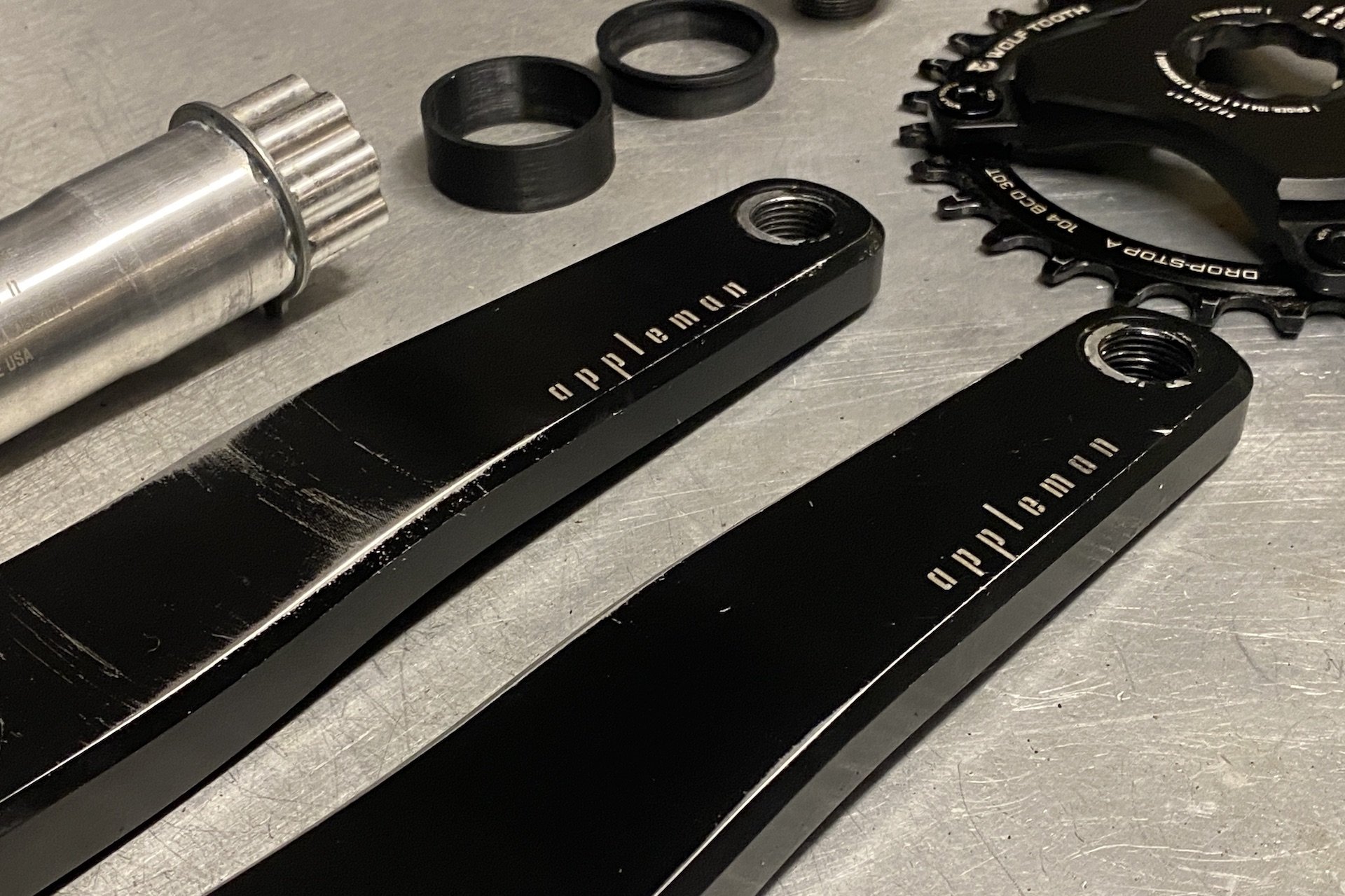
These photos were taken after only three rides and, based on the wear, I'd say Paint isn't the optimal finish for cranks bound for the North Shore. Certainly not in winter at least. Photo - Cam McRae
Matt has experimented with different crank lengths riding Strava-recorded loops, and he's fastest with 145s as well. Obviously this isn't scientific, and Matt's performance could be related to how accustomed he is to that length, but it's intriguing nonetheless.
I have fairly long legs for my height and as a result I always used to run 175 mm cranks. Recently, in a quest for better pedal clearance, I've been trying 165s and in terms of efficiency I've noticed... nothing at all. Hearing that Matt was riding 145s got me thinking. He had sent me 165s but during our conversation, I became intrigued with trying 145s.
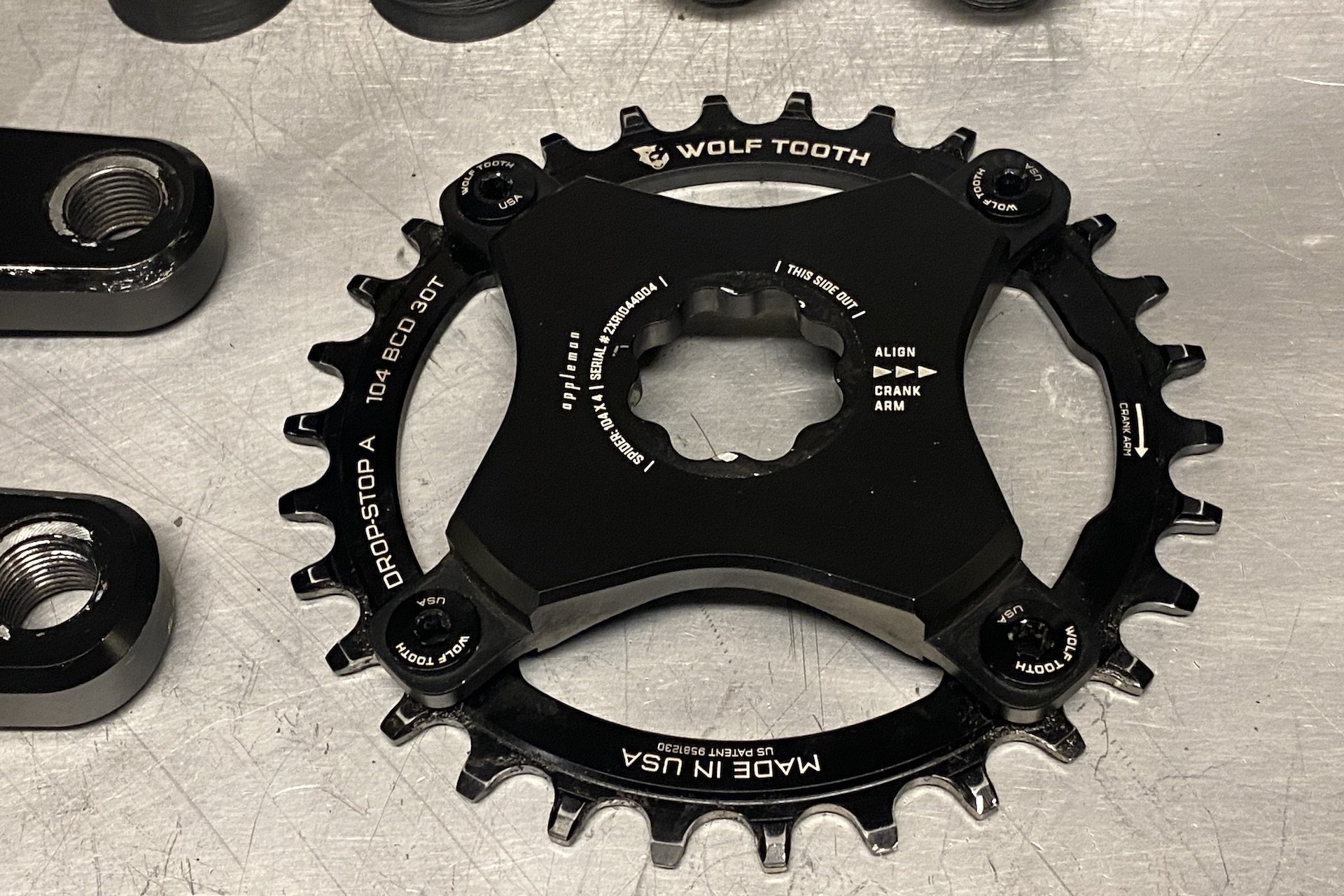
Unlike most cranks, the 2XR spider doesn't attach to the crank arm. It's splined to mate with the spindle and then is sandwiched by the crank arm. Photo - Cam McRae
Technical mountain biking on modern, low-slung bikes, is an ideal application for short cranks. They allow you to pedal through more rocky sections without banging (and potentially damaging) a pedal or crank arm on the way through and messing up your rhythm. There is a downside for mountain bikers however. Saddle height is determined by your leg's extended position so shorter cranks mean your saddle will have to be raised to maintain the same pedalling position. That's not a big deal for the way up, but it means your dropper will be higher in its lowered position for the descent. I have come to prefer a dropper of over 200 mm and I'll be very sensitive to an extra 20 mm of saddle height between my legs. It's possible that, with shorter cranks, slightly less leg extension will work fine, since higher cadence will make sense, but that remains to be seen.
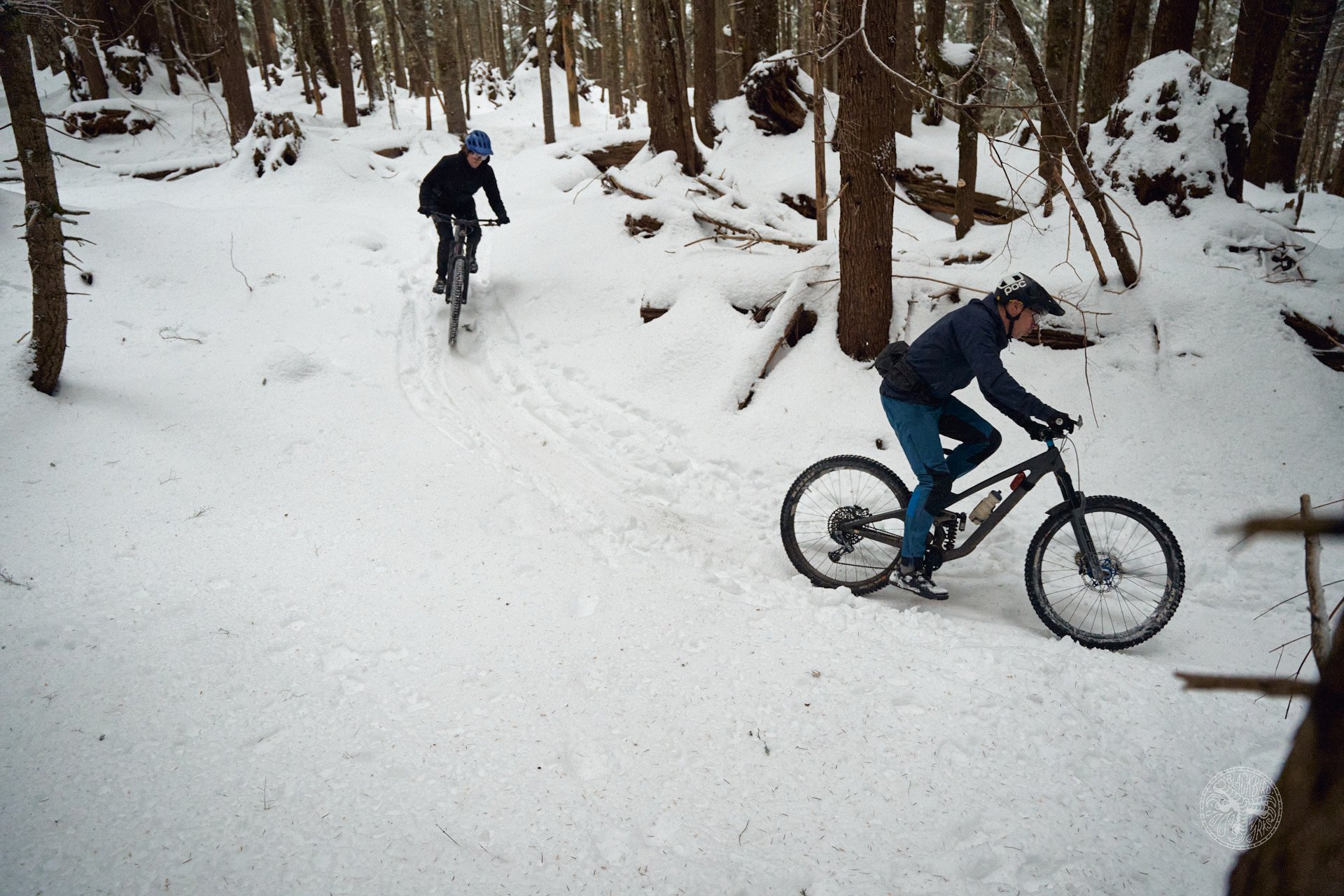
Appleman cranks at home on the made in B.C. We Are One Arrival. Photo Deniz Merdano
From Frames to Cranks
The transition to a more scalable product wasn't easy as Matt explains, "it's the first thing I've ever sold that I don't do a hundred percent of everything. So it's a different mentality." Matt designed the 2XR cranks with the customer in mind and an eye on user serviceability, which is why there are no proprietary tools required to install or remove the cranks. In fact it can all be done with a 5 mm hex key in less than 5 minutes.
A local machine shop, run by cyclists, takes care of shaping the billet aluminum into a pair of crank arms, a spindle, and a spider, but that still leaves lots of hand work for Matt. And I mean Matt himself; the machining is the only thing he contracts out. He also paints each crankset to the specifications of the customer, with 10 colours to choose from. Matt even encourages mixing and matching so you could have each arm a different colour, or a contrasting spider and spindle bolts. Even the black and silver cranks are painted, or clear coated in the case of silver, but Matt concedes he may eventually anodize those. Before the paint, he rounds the edges by hand and does any required de-burring and finally Matt laser etches the torque specs, serial number and his last name.
Since the cranks are all made to order, Matt has a one to two week turnaround, which doesn't sound too bad at all considering the hand-crafted custom bits you get at the end.

Initially I had mounted the Wolf Tooth ring on the outside of the crank spider, which put the directional ring on backwards. Eventually I found out the ring is supposed to go on the inside of the spider for mountain applications. Photo Deniz Merdano
The older I get, the more leery I am of the status quo. Habits and rituals that remain unexamined rarely stand up to scrutiny. As a group, mountain bikers are fond of doing things the way they have always been done; the first frames were roughly based on road geometry, 26" wheels came from cruiser bikes, and narrow bars, long stems and rim brakes made no sense at all. I've often wondered why we ride the crank lengths we do but I've never found either good research or any common sense justification for the usual, "tall people ride 175s and shorter people go down in increments of 2.5 or 5 mm from there." I could go deeper on this, but I'd just be regurgitating the good work Matt has already done. He's written a clear and useful guide, complete with GIFs to illustrate the issue and a crank length calculator, that will explain why it might be time to jettison the status quo.
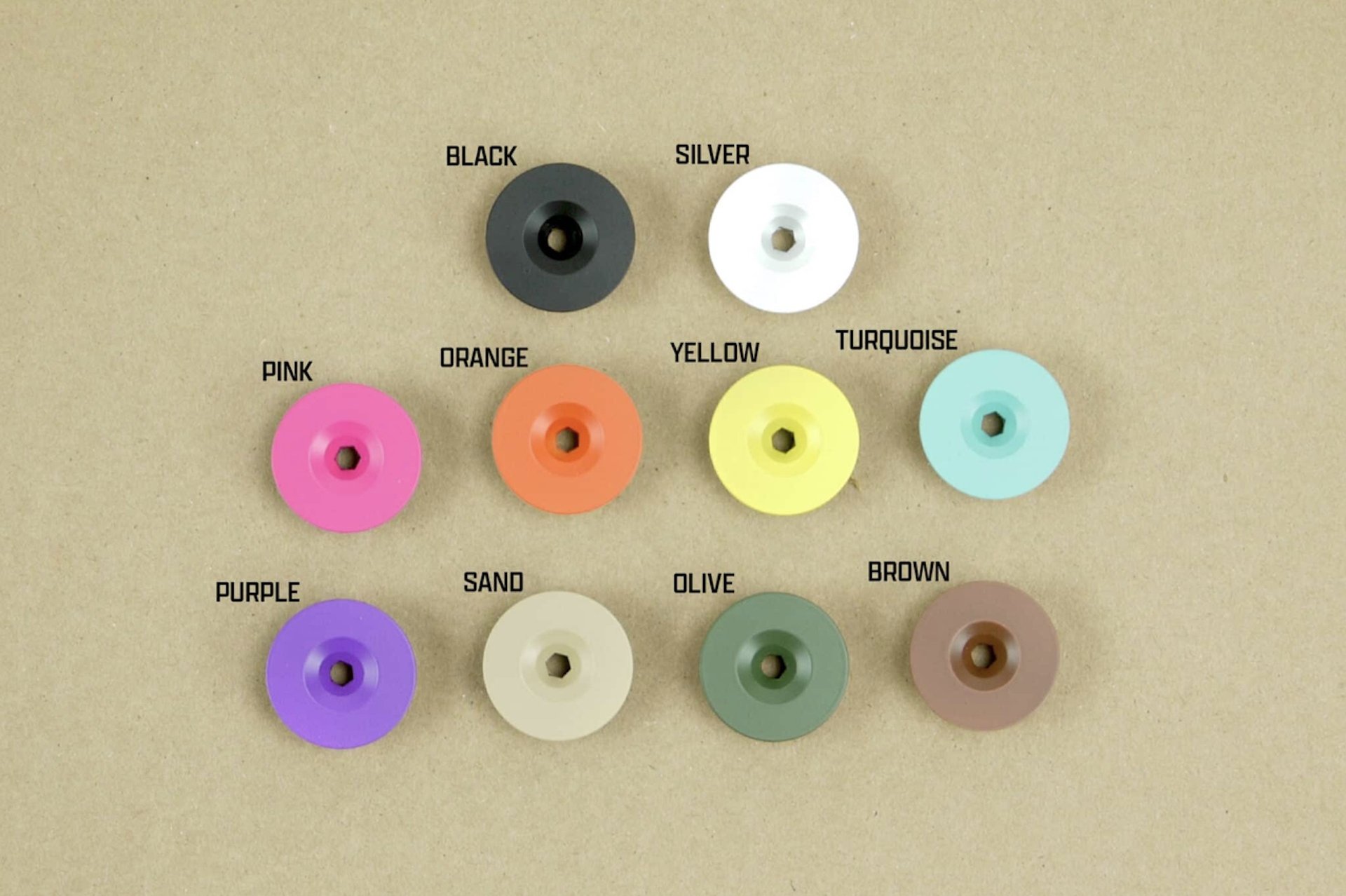
You can do whatever you like with these colours - mix and match like a mofo.

If you want to go for it, these are the cranks for you.
The next step is in the mail. Matt is mailing me some 145 mm crank arms he had around the shop and I'm going to do some experimenting. Because the cranks are so quick to swap, I'm going to put the extra set in my fanny pack and then ride sections of trail on the 165s and then install the 145s to see what I notice. Aside from increased clearance, I'm most interested in seeing what I notice once my feet are 40 mm closer together when level, which is how I corner as well as descend. I know my body has developed asymmetrically because of all the time I spend with my left foot forward and I notice a difference in the stiffness of my hips in particular.
So far, aside from the finish taking quite an early beating, from this flat pedal-rider's shoes and North Shore winter conditions, these cranks have been excellent. Now that I'm a mostly reformed weight weenie, I'd happily ride Appleman 2XR cranks for the rest of my days.
Black and silver = $485
Colours: crank arms +$50, spindle bolts +$25, spider +$25
Weight - 556 grams (mountain w/165 mm arms)
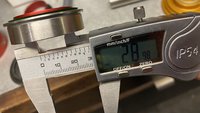


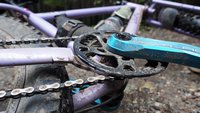


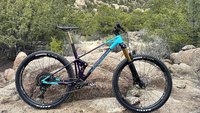


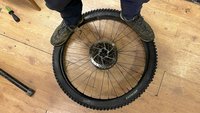

Comments
Jerry Willows
1 year, 3 months ago
In theory, shorter cranks on a bike can improve power transfer by reducing the distance that the pedals are from the bottom bracket. This reduces the leverage that the rider has over the pedals, which can make it easier to apply power to the pedals throughout the entire pedal stroke. Additionally, shorter cranks can also reduce the amount of flex in the pedal and crank system, which can also help to improve power transfer. This is because less flex in the system means that more of the rider's energy is going into propelling the bike forward, rather than being absorbed by the flex in the cranks.
The length of the cranks can affect the rider's ability to maintain a steady cadence, particularly when climbing. Longer cranks generally provide more leverage, making it easier to turn the pedals at a lower cadence, which can be beneficial for riders who prefer to climb at a lower cadence. However, shorter cranks can be beneficial for riders who prefer to spin at a higher cadence as they reduce the leverage and make it easier to turn the pedals quickly.
Longer cranks = grinders
Shorter cranks = spinners
I pedal at a really low cadence and noticed that going from 175 to 170 that it was harder to maintain the pace in the same gear.
Reply
Mammal
1 year, 3 months ago
"I pedal at a really low cadence and noticed that going from 175 to 170 that it was harder to maintain the pace in the same gear."
I noticed the same thing, but still adapted, because I like the extra clearance for modern, low-BB, mid-travel bikes. I stick with 170 for trail, and 165 for DH where I don't really care much about pedaling performance.
Although the crank/pedal flex is somewhat of a factor, I think that if you measured the power loss between sizes, it would be negligible compared to other factors going on with a bike under pedal power. Also, not all that deflection results in power loss, since it's more of a spring system that would return at least some of that deflection as your power-stroke ends.
Reply
Andy Eunson
1 year, 3 months ago
I’m a low cadence rider too. Thing is, a high cadence off road can lead to bouncing and less control. Too low a gear when a rider is hunting for traction will cause one to spin out. Just like snow mode in certain cars that eliminates low gear when starting from a stop or manually putting the transmission in 2nd gear to eliminate wheel spin.
The other thing with far shorter cranks is you would need to raise the bar height as much as you shortened the cranks. Lots of bikes now are already lower than many riders like. Dropping the bb would add some stability I suppose and still have similar pedal clearance.
I don’t know if really short cranks are a solution looking for a problem or what. I’d like to try shorter cranks just to see what it’s like. Being 5’4" but with a 31 inseam I think I’m an outlier in terms of proportions and fit and me on shorter cranks than a taller riders makes sense. I’d like to see some real science though on crank length and what effect various lengths have. I’ve never seen much on that and the few I’ve read suggest that we are best with what we are used to. But we are mostly pretty adaptable to different things once we give them a fair shot.
Reply
AndrewR
1 year, 3 months ago
The only immediate criticism/ observation is that choosing a 104 x 4 standard means the smallest chain ring is 30T.
Fine for a fit rider dealing with Whistler/ Pemberton/ Rockies/ Alpes & Madeira type climb grades but not really small enough for fat biking or bike packing. Exactly the type of bike that a shorter crank that encourages a higher cadence might benefit from.
Perhaps a "spider"/ carrier that allowed the use of DM chain rings would open these cranks up and make them more versatile.
Reply
rusty904
1 year, 3 months ago
It seems like a DM chainring would be easy enough to make with that interface but it would have a lot of offset. I really don't like dealing with 4 or 5 bolt chainrings anymore esp without captive nuts on one end.
Reply
ElGenerale
1 year, 3 months ago
I'm a step ahead of you all here, with my mullet set up. You heard right: 155mm LH crank, 175mm RH crank. Send it!
Reply
TristanC
1 year, 3 months ago
I think the Appleman 2XR FIT Crank that Matt has on his site is going to be hugely helpful for a lot of people. Personally, I tried going to 165mm cranks from my usual 175mm, and it actually caused knee pain - it felt like there was extra strain right above the knee. But, I am tall (188cm) and have absurdly long calves and a short torso. My knee angle was at 75° with the 165mm cranks - even with 175mm, it's still 72.5°ish. It's definitely a what-works-for-you sizing, and I'm glad to see more options becoming available.
Reply
Alex D
1 year, 3 months ago
Did you move the saddle back when you tried the shorter cranks?
Reply
Offrhodes42
1 year, 3 months ago
As a height challenged individual (5'4") with long legs (30.5") inseam I am intrigued by the shorter cranks. I have always run 170mm cranks on every bike (road, cross, gravel, trail) with the exception of my DH bike at 165mm. I would be inclined to try 155mm, but this would be a very expensive experiment. I am hoping many reviews and testing will pop up over the next year to give me more information and data points to go from.
Reply
bushtrucker
1 year, 3 months ago
Canfield do a bunch of affordable cranks in 155 that you could try.
Reply
Moritz Haager
1 year, 3 months ago
This is great! At 5’6 and a wife who is 5’2, I am always irritated how it seems like all bikes just come with 175 mm cranks irregardless of size, and not even mentioning kids bikes. I actually started running 165’s first on my TT bike for triathlon as shorter cranks cause less pelvis rocking making the position more comfortable. I have also came across papers saying that the bio mechanical effect of shorter vs longer cranks is non-existent, that you really are not sacrificing power when moving to shorter cranks.
Reply
Cee Cee
1 year, 3 months ago
Dear incompletely reformed weight wiener,
https://samox.com/product/m7j/. 375g for 145mm; USD 375
Also, https://www.trailcraftcycles.com/product/direct-mount-cranks-arms-only/. 525g for 152mm; USD 169
Regards, made in Taiwan
P.s. the 'gut punching' afforded by longer levers is complemented by greater stress on the fulcrums of the assemblage, accented by the more uneven stroke, independent of rider height. See common cycling injuries
Reply
Velocipedestrian
1 year, 3 months ago
Thanks for the links, those Trailcraft cranks are the first I can think of beyond RF Aeffect R with a 24mm spindle + common ring mount standard.
Reply
JT
1 year, 3 months ago
Set up a set of Canfiled 155s on my Trance X and couldn't be happier with the results. Soon to do the same to my hardtail and my cross bike. The extra clearance is noticeable and the resultant spin to win formula is just silly easy. Combined with an oval ring I was blown away about how efficient the set up felt. Granted, I do need to get a longer dropper on now, so it does bring more outta the wallet but it isn't a necessary upgrade as yet.
But regarding billet machined cranks in general, I have a wait and see attitude. The harsh memories of Kooka and Double Barrel cranks still linger after all these years, as do the hubshell failures of a few notable hub manufacturers in modern times. There's nothing like tying up your leg with a bandana to walk the 5mi back to the car to then go get stitched up, or grabbing your bike to go ride only to notice the spoke tension is gone because the hubshell split. To say I'm gunshy is an understatement.
Reply
GB
1 year, 3 months ago
My much loved Saint cranks can be removed with almost the same ease . Two pinch bolts verses one . Big fan of not changing standards . The 4 bolt spiders are refreshing to see.
The Saints I have are 165 mm . Honestly I can't feel more or less power transfer to the pedals .
If my anatomy caused knee pain I could see the change making a difference not in performance. Something much more important . Enjoying a ride with out pain or complications.
Stoked to see parts made in North America. Yes my favorite experience, meeting the minds behind a great baker brewery or bike parts maker .
Reply
cyclotoine
1 year, 3 months ago
I'm watching the crank-length debate with amusement. Short cranks are the next big thing. Long crank never really caught on but I dove deep into that about 20 years ago. I was mostly riding road at the time. I noticed that one big mountain climbs I was going up quicker on 180mm cranks and even still have some 185mm cranks hanging in the basement. I still 180mm cranks on all my road bikes/commuting and cross bikes but honestly would probably be happier on 175mm just because 98% of my riding is on my mountain or fat bike which were 175mm until 170mm seemed to become mountain standard. Now when I jump on my road and commuter after riding around on 170mm all the time it feels like I'm out of shape. What I've decided is you will condition your legs to the length you ride the most. I noticed a little loss of climbing prowess when I first got 170mm cranks but now it really doesn't bother me and the bit of extra clearance is good. Being 6'3" though 170-175 seems about right for me anyway.
Reply
tripsforkidsvancouver
1 year, 3 months ago
We didn't hear what Matt's height was but at 6"3 with a 36" inseam and stratospherically high post that threatens to send me over the bars constantly, any change that puts the seatpost higher (e.g. short cranks) is an absoluate no-go. Is Matt shorter? Makes sense shorter legs would like shorter cranks and vice-versa for my long legs. Nice looking cranks regardless!
Reply
Cee Cee
1 year, 3 months ago
It's drop that threatens, not max saddle height, which is stratospherically variable, along with stack
Reply
MTB_THETOWN
1 year, 3 months ago
I am 5-10/178cm and have a strong preference for 165mm cranks, but haven't had the chance to try anything shorter. I think at a certain point the loss of leverage makes shorter cranks harder to pedal, but I'm not sure where that point is.
Reply
JT
1 year, 3 months ago
I'm 5'10" with a 32" inseam. When I made the swap it reminded me a bit of when I first rode track bikes with 165s compared to the 175s on my road and MTB bikes; kinda weird but the more you rode em, the better it felt. Where I really noticed a change was tech climbs. I was spinning a lot easier, maintaining better traction through the climbs. On the descents I could be a bit looser in where I was pedaling as the 15mm of clearance gain was noticeable (or at least psychological enough that it was). Of course, I had to relearn where that limit was at :D. On the flats I didn't notice any real difference when sprinting aside from it being easier to maintain a spin once up to speed. One of my pals gives me grief about the shorties, but even his former Cat 1 racin' butt had to admit I was riding better, maintaining momentum better, than I had in the past. Jumping really had no difference in feel between the two, but it could be I was focusing on facing up trannies rather than how the new foot position was.
Reply
Codey Chmilar
1 year, 3 months ago
This winter I have been in the process of shortening the cranks on most of my kids' bikes.
24" wheel bike came with 152mm cranks -> changed to 127mm
20" wheel bike had 140mm -> changed to 110mm
16" bike had 114mm -> changed to 102mm
This was driven mostly based on hip angle (and pedal strikes on the 20" bike).
I am on the taller side (189cm) and most of my road bikes have 175mm cranks with no issues. That said, I have ridden bikes with shorter cranks (170mm and 172.5) to no ill effect. If I were to build a road bike now, I would likely choose 170mm cranks . I see no downside to going shorter. For mountain bikes I currently run 170mm and would go shorter on a new build.
For those curious about trying shorter cranks, all of the above cranks were purchased from AliExpress, and thus far I have been impressed by the quality for the price. All were less than $90 shipped to Canada. Mind you, the kids won't be taxing them too much. I can't say how they will hold up to a 200+ pound rider doing park laps all day.
Reply
olrustybones
1 year, 3 months ago
As someone with two really young kids and hardly time to ride, I am curious about how these cranks change caloric expenditure. I want to burn lots of calories riding, not have something more efficient. If you change your gearing to stay the same does energy stay the same?
Reply
olrustybones
1 year, 3 months ago
I think I may have answered my own question...
Reply
Cee Cee
1 year, 3 months ago
This comment has been removed.
Please log in to leave a comment.